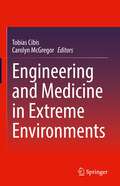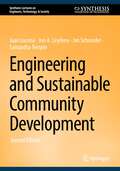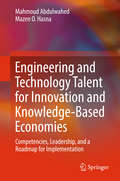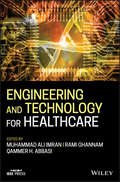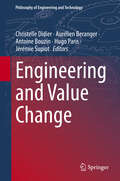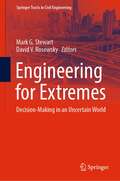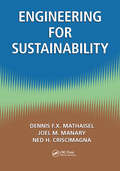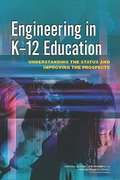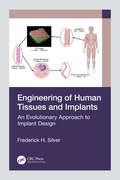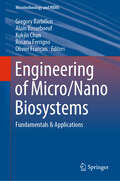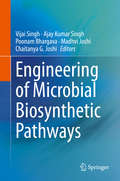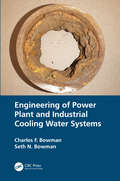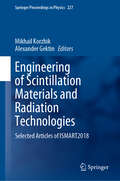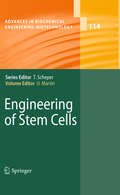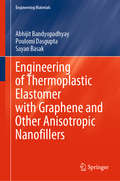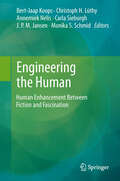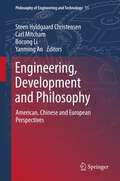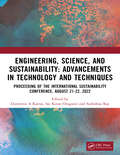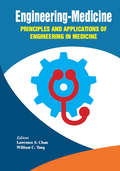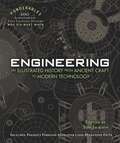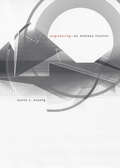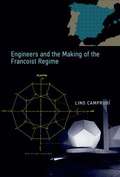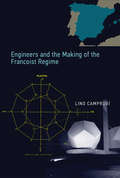- Table View
- List View
Engineering and Medicine in Extreme Environments
by Tobias Cibis Carolyn McGregor AmThis book brings together in-depth information on a wide array of bio-engineering topics and their application to enhance human health, performance, comfort, and survival in extreme environments. Contributions from biomedical engineering, information systems, medicine and physiology, and medical engineering are presented in relation to a broad range of harsh and extreme environmental scenarios, including underwater, terrestrial (both natural and man-made), and space travel. Physicians, engineers, and scientists, as well as researchers and graduate students, will find the book to be an invaluable resource.Details effects of extreme environments on human physiology;Presents human-environment interaction in different scenarios;Overview of engineering challenges and problems in extreme environments.
Engineering and Sustainable Community Development (Synthesis Lectures on Engineers, Technology, & Society)
by Jen Schneider Juan Lucena Jon A. Leydens Samantha TempleThis book presents an overview of engineering as it relates to humanitarian engineering, service-learning engineering, peace engineering, or engineering for community-led development, programs that are often grouped under Engineering for Good or Engineering for Change. By placing “community” at the center of these endeavors, this book invites readers and practitioners to strive for sustainable community development (SCD). This 2nd edition is centered on new concepts of community-led development and includes topics on the history of engineers and development, the problems of using industry-based practices when designing for communities, how engineers can prepare to work with communities, and listening in community development. Two case studies are provided to highlight the book’s concepts using first-hand experiences of engineers engaged with communities—one of engineers developing a windmill for a community in India, and a second of an engineer mapping communities in Honduras for improved water management. The book concludes with student perspectives and experiences from a curricular model focused on engineering for sustainable community development. Overall, the text invites engineers to reflect and prepare themselves for global careers that involve international development in both the for-profit and non-profit sectors. This 2nd edition places community-led practices at the heart of these endeavors. The book is for engineering faculty, students and practicing engineers, involved in current or future community collaborations. The authors wrote this book with a goal to help readers critically reflect on their own practices and perceptions. Readers learn to question past, current, and future frameworks in the project of development, and are encouraged to adopt practices of community-led development. This 2nd edition is aimed at engineering students who, as future global engineers, are faced with opportunities and challenges when working with communities. As funding for renewable energy, “green jobs,” and community-based initiatives continue to increase, engineers will need to rely on the social and historical concepts presented in this book.
Engineering and Technology Talent for Innovation and Knowledge-Based Economies: Competencies, Leadership, and a Roadmap for Implementation
by Mahmoud Abdulwahed Mazen O. HasnaThis book introduces and analyzes the models for engineering leadership and competency skills, as well as frameworks for industry-academia collaboration and is appropriate for students, researchers, and professionals interested in continuous professional development. The authors look at the organizational structures of engineering education in knowledge-based economies and examine the role of innovation and how it is encouraged in schools. It also provides a methodological framework and toolkit for investigating the needs of engineering and technology skills in national contexts. A detailed empirical case study is included that examines the leadership competencies that are needed in knowledge-based economies and how one university encourages these in their program. The book concludes with conceptual modeling and proposals of specific organizational structures for implementation in engineering schools, in order to enable the development of necessary skills for future engineering graduates.
Engineering and Technology for Healthcare (Wiley - IEEE)
by Muhammad Ali Imran Qammer H. Abbasi Rami GhannamInnovation in healthcare is currently a “hot” topic. Innovation allows us to think differently, to take risks and to develop ideas that are far better than existing solutions. Currently, there is no single book that covers all topics related to microelectronics, sensors, data, system integration and healthcare technology assessment in one reference. This book aims to critically evaluate current state-of-the-art technologies and provide readers with insights into developing new solutions. With contributions from a fully international team of experts across electrical engineering and biomedical fields, the book discusses how advances in sensing technology, computer science, communications systems and proteomics/genomics are influencing healthcare technology today.
Engineering and Value Change (Philosophy of Engineering and Technology #48)
by Christelle Didier Aurélien Béranger Antoine Bouzin Hugo Paris Jérémie SupiotThis volume consists of chapters derived from the best papers submitted to the 2023 Forum on Philosophy, Engineering, and Technology (fPET) meeting that took place in April 2023 at Delft University of Technology. Topics and fields covered within the volume include applied ethics, meta-ethics, value theory, education, responsible innovation, political philosophy and value-sensitive design. The contributors present research that addresses the challenges of engineering in a changing world. This text is of interest to students and researchers working in the fields of engineering and philosophy.
Engineering for Extremes: Decision-Making in an Uncertain World (Springer Tracts in Civil Engineering)
by Mark G. Stewart David V. RosowskyThe volume explains how risk and decision-making analytics can be applied to the wicked problem of protecting infrastructure and society from extreme events. There is increasing research that takes into account the risks associated with the timing and severity of extreme events in engineering to reduce the vulnerability or increase the resiliency of infrastructure. "Engineering for extremes" is defined as measures taken to reduce the vulnerability or increase the resiliency of built infrastructure to climate change, hurricanes, storms, floods, earthquakes, heat waves, fires, and malevolent and abnormal events that include terrorism, gas explosions, vehicle impact and vehicle overload. The book introduces the key concepts needed to assess the economic and social well-being risks, costs and benefits of infrastructure to extreme events. This includes hazard modelling (likelihood and severity), infrastructure vulnerability, resilience or exposure (likelihood and extent of damage), social and economic loss models, risk reduction from protective measures, and decision theory (cost-benefit and utility analyses). Case studies authored by experts from around the world describe the practical aspects of risk assessment when deciding on the most cost-efficient measures to reduce infrastructure vulnerability to extreme events for housing, buildings, bridges, roads, tunnels, pipelines, and electricity infrastructure in the developed and developing worlds.
Engineering for Sustainability
by Dennis F.X. Mathaisel Joel M. Manary Ned H. CriscimagnaSustainability and sustainable development have become popular goals. They have also become wide-ranging terms that can be applied to any entity or enterprise on a local or a global scale for long time periods. As enterprises and systems become more complex and development a support costs increase, the question remains: how does one engineer an ent
Engineering in K-12 Education: Understanding the Status and Improving the Prospects
by National Academy of Engineering National Research Council of the National AcademiesEngineering education in K-12 classrooms is a small but growing phenomenon that may have implications for engineering and also for the other "STEM" subjects--science, technology, and mathematics. Specifically, engineering education may improve student learning and achievement in science and mathematics, increase awareness of engineering and the work of engineers, boost youth interest in pursuing engineering as a career, and increase the technological literacy of all students. The teaching of STEM subjects in U.S. schools must be improved in order to retain U.S. competitiveness in the global economy and to develop a workforce with the knowledge and skills to address technical and technological issues. Engineering in K-12 Education reviews the scope and impact of engineering education today and makes several recommendations to address curriculum, policy, and funding issues. The book also analyzes a number of K-12 engineering curricula in depth and discusses what is known from the cognitive sciences about how children learn engineering-related concepts and skills. Engineering in K-12 Education will serve as a reference for science, technology, engineering, and math educators, policy makers, employers, and others concerned about the development of the country's technical workforce. The book will also prove useful to educational researchers, cognitive scientists, advocates for greater public understanding of engineering, and those working to boost technological and scientific literacy.
Engineering of Human Tissues and Implants: An Evolutionary Approach to Implant Design
by Frederick H. SilverThis text presents information on biological control systems, mechanotransduction, tissue structure, and function, as well as properties that can be integrated together to provide improved implant and device designs. This information is needed to develop new diagnostic tests and instruments that provide early diagnostic tests and treatments for diseases.Engineering of Human Tissues and Implants: An Evolutionary Approach to Implant Design provides basic scientific information on the evolutionary design of tissues and organs that are a result of living in a gravitational field. Much of the useful information that is available for the design of implants is based on tissue structure and function derived from light and electron microscopy observations. However, this information is not enough for developing new designs of implants and medical devices since much of the biological response to implants is based on understanding the biological control systems and mechanotransduction that drive many of the responses seen with implanted devices. The book also introduces mechanotransduction as it relates to implant design with an overview of materials and their use in applications that include those materials designed to treat wounds, burns, facial, hernial, ophthalmic, oral, cardiovascular, and tendon/ligaments.This book is intended for biomedical science and engineering students who are learning about artificial implants and medical device development. It will also be of significance to other engineering majors interested in the design of devices for diagnoses and measuring of physiological parameters, as well as to clinicians and researchers who are interested in mechanobiology.
Engineering of Micro/Nano Biosystems: Fundamentals & Applications (Microtechnology and MEMS)
by Gregory Barbillon Alain Bosseboeuf Kukjin Chun Rosaria Ferrigno Olivier FrançaisThis tutorial book offers an in-depth overview of the fundamental principles of micro/nano technologies and devices related to sensing, actuation and diagnosis in fluidics and biosystems. Research in the MEMS/NEMS and lab-on-chip fields has seen rapid growth in both academic and industrial domains, as these biodevices and systems are increasingly replacing traditional large size diagnostic tools. This book is unique in describing not only the devices and technologies but also the basic principles of their operation.The comprehensive description of the fabrication, packaging and principles of micro/nano biosystems presented in this book offers guidance for researchers designing and implementing these biosystems across diverse fields including medical, pharmaceutical and biological sciences. The book provides a detailed overview of the fundamental mechanical, optical, electrical and magnetic principles involved, together with the technologies required for the design, fabrication and characterization of micro/nano fluidic systems and bio-devices.Written by a collaborative team from France and Korea, the book is suitable for academics, researchers, advanced level students and industrial manufacturers.
Engineering of Microbial Biosynthetic Pathways
by Ajay Kumar Singh Vijai Singh Poonam Bhargava Madhvi Joshi Chaitanya G. JoshiThis book provides a comprehensive overview of the basic and advanced metabolic engineering technologies used to generate natural metabolites and industrially important biomolecules. Metabolic engineering has the potential to produce large quantities of valuable biomolecules in a renewable and sustainable manner by extending or modifying biosynthetic pathways in a wide range of organisms. It has been successfully used to produce chemicals, drugs, enzymes, amino acids, antibiotics, biofuels, and industrially important pharmaceuticals. The book comprehensively reviews the various metabolites detection, extraction and biosensors and the metabolic engineering of microbial strains for the production of industrially useful enzymes, proteins, organic acids, vitamins and antibiotics, therapeutics, chemicals, and biofuels. It also discusses various genetic engineering and synthetic biology tools for metabolic engineering. In closing, the book discusses ethical, patenting and regulatory issues in the metabolic engineering of microbes. This book is a valuable source not only for beginners in metabolic engineering, but also students, researchers, biotechnology and metabolic engineering based company.
Engineering of Power Plant and Industrial Cooling Water Systems
by Charles F. Bowman Seth N. BowmanThis book provides a reference to analysis techniques of common cooling water system problems and a historical perspective on solutions to chronic cooling water system problems, such as corrosion and biofouling. It covers best design practices for cooling water systems that are required to support the operation of all electric power plants. Plant engineers will gain better understanding of the practical issues associated with their cooling water systems and new designs or modifications of their systems should consider the actual challenges to the systems. The book is intended for graduate students and practicing engineers working in both nuclear and fossil power plants and industrial facilities that use large amounts of cooling water.
Engineering of Scintillation Materials and Radiation Technologies: Selected Articles of ISMART2018 (Springer Proceedings in Physics #227)
by Alexander Gektin Mikhail KorzhikThis proceedings book presents dual approaches to examining new theoretical models and their applicability in the search for new scintillation materials and, ultimately, the development of industrial technologies. The ISMART conferences bring together the radiation detector community, from fundamental research scientists to applied physics experts, engineers, and experts on the implementation of advanced solutions. This scientific forum builds a bridge between the different parts of the community and is the basis for multidisciplinary, cooperative research and development efforts. The main goals of the conference series are to review the latest results in scintillator development, from theory to applications, and to arrive at a deeper understanding of fundamental processes, as well as to discover components for the production of new generations of scintillation materials. The book highlights recent findings and hypotheses, key advances, as well as exotic detector designs and solutions, and includes papers on the microtheory of scintillation and the initial phase of luminescence development, applications of the various materials, as well as the development and characterization of ionizing radiation detection equipment. It also touches on the increased demand for cryogenic scintillators, the renaissance of garnet materials for scintillator applications, nano-structuring in scintillator development, trends in and applications for security, and exploration of hydrocarbons and ecological monitoring.
Engineering of Stem Cells
by Ulrich MartinThis text covers all aspects of this modern biotechnology in which knowledge, methods and expertise are required from chemistry, biochemistry, microbiology, genetics, chemical engineering and computer science.
Engineering of Thermoplastic Elastomer with Graphene and Other Anisotropic Nanofillers (Engineering Materials)
by Abhijit Bandyopadhyay Poulomi Dasgupta Sayan BasakThis book is an effort to tether all the exuberant observations on adding nanomaterial in the TPE matrix. With an enhanced processing property along with amplified recyclability and reprocessing feature, thermoplastic elastomers (TPE) proves to be one of the most significant polymeric materials till date. As the scientific world evolves, these advanced materials have attuned themselves with various anisotropic nanomaterials to induce an enhanced property effect on the final product. On an additional note, authors have done extensive research on graphene, the most multifaceted element in the filler family keeping TPE and its derivate as the matrix martial. Cogitating the idea of a multidimensional readership, authors have analyzed the synthesis, derivatization, and properties of graphene and its derivatives separately. Apart from reviewing the future prospects and the potential application of these nano-filled advanced materials, they have kept the structure–property relationship of graphene-based composites at the cynosure to provide firm understanding on the blossoming of these elastomeric composites. The authors believe this book is a potential content for both professionals and academicians.
Engineering the Future: Science, Technology and the Design Process
by Museum Of ScienceNIMAC-sourced textbook
Engineering the Human
by Monika S. Schmid Carla Sieburgh Bert Jaap Koops J.P.M. Jansen Annemiek Nelis Christoph H. LüthyThe volume is collection of articles treating the topic of human improvement/enhancement from a variety of perspectives - philosophical, literary, medical, genetic, sociological, legal etc. The chapters in this volume treat not only those aspects that most immediately come to mind when one thinks of 'human enhancement', such as genetic engineering, cloning, artificial implants and artificial intelligence etc. Somewhat less obvious aspects include evolutionary perspectives in connection with the prolongation of the human lifespan, plastic surgery since its beginnings, and questions such as whether the distinction between 'natural' and 'artificial' can really be drawn at all and how it has been conceived across the ages, or what the legal implications are of recent developments and techniques. Many papers make links to the representation of these developments in popular culture, from Jules Verne through Aldous Huxley to the movie Gattaca, address the hopes and fears that come with them as well as the question how realistic these are. While all chapters are written by scientists at the international top of their respective fields, all are accessible to a non-specialist audience and eminently readable. We believe that they represent a state-of-the art overview of questions that are of interest to a large audience. The book thus targets a non-specialist audience with an interest in philosophical, sociological, scientific and legal issues involved in both traditional and recent matters concerning the desire of mankind to improve itself, the human body, the human mind and the human condition. It is unique in that it brings together all these aspects within a coherent and cohesive collection.
Engineering to Adapt: Proceedings of Engineering to Adapt 2023 Symposium and Industry Summit (Springer Proceedings in Energy)
by David S-K. Ting Ahmad Vasel-Be-HaghThis book collates important contributions from Engineering to Adapt (ETA2023). Eta, η, the 7th letter of the Greek alphabet, is scrupulously used to denote efficiency and this is what ETA2023 strives for. In context, efficiency, η, is about avoiding waste, may this be energy, time, money, or material, in accomplishing something useful. As such, ETA2023 aims at bringing experts and future leaders together to forge more efficient ways to engineer and live. In other words, ETA2023 strives to synergise and catalyse all stakeholders, enthusiasts, and experts from academia, industry, policy arenas, and the general public, to formulate novel ways to improve tomorrow.This symposium will disseminate recent progress and promote collaborations to maximize opportunities for innovative integrated solutions. Topics of interest include resource and energy efficiency, waste reduction, and eco-friendly agriculture, architecture, engineering, and living.
Engineering, Development and Philosophy
by Carl Mitcham Steen Hyldgaard Christensen Yanming An Bocong LiThis inclusive, cross-cultural study rethinks the nexus between engineering, development, and culture. It offers diverse commentary from a range of disciplinary perspectives on how the philosophies of today's cultural triumvirate--American, European and Chinese--are shaped and given nuance by the cross-fertilization of engineering and development. Scholars from the humanities and social sciences as well as engineers themselves reflect on key questions that arise in this relational context, such as how international development work affects the professional views, identities, practice and ethics of engineers. The first volume to offer a systematic and collaborative study that cuts across continental boundaries, the book delineates the kinds of skills and competences that tomorrow's engineering success stories will require, and analyzes fascinating aspects of the interplay between engineering and philosophy, such as how traditionally Chinese ways of thinking can influence modern engineering practice in the world's most populous country. China's problematic mix of engineering woes and wonders, from the high-profile crash on its high-profile rail network to its 'bird's nest' Olympic stadium, adds to the urgency for reform, while Europe's Enlightenment-informed legal frameworks are contrasted with Chinese mechanisms in their governance of the field of nanotechnology, a crucial element of future technical evolution. Fascinating and compelling in equal measure, this volume addresses one of the topics at the leading edge of humanity's quest to survive, and to thrive.
Engineering, Science, and Sustainability: Advancements in Technology and Techniques
by Dimitrios A Karras Sai Kiran Oruganti Sudeshna RayISC 2022 is dedicated to the Niti Aayog policies to promote sustainability through exchange of ideas emerging out of the academia. The ISC is an annual conference that is held in virtual mode until COVID restrictions on travel exist. The vision of the conference is to capacitate Academia with the necessary ideas that provide insights of the grassroot level development to various stakeholders of the Niti-Aayog policies. Towards this goal, the conference creates a conjunction of various stakeholders of Niti-Aayog policies that include- academic institutions, government bodies, policy makers and industry. The ISC organizers make concerted efforts to promote academic research that would technological, scientific, management & business practices, and insights into policy merits & disruptions. The framework of exchange of ideas is geared towards adoption of deep technologies, fundamental sciences & engineering, energy research, energy policies, advances in medicine & related case studies. This framework enables the round table discussions between the academia, industry and policy makers through its range of plenary and keynote speakers.
Engineering-Medicine: Principles and Applications of Engineering in Medicine
by Lawrence S. Chan and William C. TangThis transformative textbook, first of its kind to incorporate engineering principles into medical education and practice, will be a useful tool for physicians, medical students, biomedical engineers, biomedical engineering students, and healthcare executives. The central approach of the proposed textbook is to provide principles of engineering as applied to medicine and guide the medical students and physicians in achieving the goal of solving medical problems by engineering principles and methodologies. For the medical students and physicians, this proposed textbook will train them to “think like an engineer and act as a physician”. The textbook contains a variety of teaching techniques including class lectures, small group discussions, group projects, and individual projects, with the goals of not just helping students and professionals to understand the principles and methods of engineering, but also guiding students and professionals to develop real-life solutions. For the biomedical engineers and biomedical engineering students, this proposed textbook will give them a large framework and global perspective of how engineering principles could positively impact real-life medicine. To the healthcare executives, the goal of this book is to provide them general guidance and specific examples of applying engineering principles in implementing solution-oriented methodology to their healthcare enterprises. Overall goals of this book are to help improve the overall quality and efficiency of healthcare delivery and outcomes.
Engineering: An Illustrated History from Ancient Craft to Modern Technology
by Tom JacksonFrom ancient aqueducts to soaring skyscrapers, explore engineering milestones over the centuries. Combining engaging text with captivating images and helpful diagrams, renowned science writer Tom Jackson guides readers through the history of Engineering in the 7th installment of the groundbreaking PonderablesTM series. Engineering is all around us. From our bridges, tunnels and skyscrapers, to our cars, computers and smartphones, engineering shapes our world and influences just about everything we see and do. And it s been that way for longer than you might think. From the crudely knapped hand axes of our human ancestor Homo Habilis to the mind-blowing ways in which modern engineering has improved our quality of daily life and expanded the scope of our civilization, the story of engineering is the story of humankind itself. In a series of 100 enlightening articles, this book tells that incredible story by exploring the biggest names, grandest achievements and greatest inventions of the engineering world from prehistory all the way up to present day. Carefully curated, beautifully illustrated and addictively fun, this volume is your ultimate guide to the dreamers, thinkers, tinkerers and builders that make our world.
Engineering—An Endless Frontier
by Sunny Y. AUYANGGenetic engineering, nanotechnology, astrophysics, particle physics: We live in an engineered world, one where the distinctions between science and engineering, technology and research, are fast disappearing. This book shows how, at the dawn of the twenty-first century, the goals of natural scientists--to discover what was not known--and that of engineers--to create what did not exist--are undergoing an unprecedented convergence. Sunny Y. Auyang ranges widely in demonstrating that engineering today is not only a collaborator with science but its equal. In concise accounts of the emergence of industrial laboratories and chemical and electrical engineering, and in whirlwind histories of the machine tools and automobile industries and the rise of nuclear energy and information technology, her book presents a broad picture of modern engineering: its history, structure, technological achievements, and social responsibilities; its relation to natural science, business administration, and public policies. Auyang uses case studies such as the development of the F-117A Nighthawk and Boeing 777 aircraft, as well as the experiences of engineer-scientists such as Oliver Heaviside, engineer-entrepreneurs such as Henry Ford and Bill Gates, and engineer-managers such as Alfred Sloan and Jack Welch to give readers a clear sense of engineering's essential role in the future of scientific research. Table of Contents: Preface 1. Introduction 2 . Technology Takes Off 2.1 From Practical Art to Technology 2.2 Construction Becomes Mathematical 2.3 Experimenting with Machines 2.4 Science and Chemical Industries 2.5 Power and Communication 3. Engineering for Information 3.1 From Microelectronics to Nanotechnology 3.2 Computer Hardware and Software 3.3 Wireless, Satellites, and the Internet 4. Engineering in Society 4.1 Social Ascent and Images of Engineers 4.2 Partnership in Research and Development 4.3 Contributions to Sectors of the Economy 5. Innovation by Design 5.1 Inventive Thinking in Negative Feedback 5.2 Design Processes in Systems Engineering 5.3 “Working Together� in Aircraft Development 5.4 From Onboard Computers to Door Hinges 6. Sciences of Useful Systems 6.1 Mathematics in Engineering and Science 6.2 Information and Control Theories 6.3 Wind Tunnels and Internet Simulation 6.4 Integrative Materials Engineering 6.5 Biological Engineering Frontiers 7. Leaders Who Are Engineers 7.1 Business Leaders in the Car Industry 7.2 Public Policies and Nuclear Power 7.3 Managing Technological Risks Appendix A. Statistical Profiles of Engineers Appendix B. U.S. Research and Development Notes Index I am impressed by the scope of Engineering - An Endless Frontier, and fascinated by Sunny Auyang's comprehensive knowledge of the subject. This is just the kind of book the National Academy of Engineering has been encouraging to promote the importance of engineering to the public. It will have a long shelf-life in that it pulls together material that is not readily accessible, and will serve as a reference for anyone interested in engineering as a profession. Engineering needs this book!--John Hutchinson, Harvard UniversityEngineering - An Endless Frontier is extraordinary in scope. Sunny Auyang describes the different kinds of contemporary engineering practices and productions, attempts to provide historical background, explains the scientific basis for engineering innovation in different fields, and addresses the broad, systems level managerial, entrepreneurial, and design activities of professionals. It's rare to find a single author who can grasp and explain the essential features of modern technologies across such an array of industrial sectors and engineering disciplines and explain how they work, why they work they way they do,
Engineers and the Making of the Francoist Regime
by Lino CamprubíIn this book, Lino Camprubí argues that science and technology were at the very center of the building of Franco's Spain. Previous histories of early Francoist science and technology have described scientists and engineers as working "under" Francoism, subject to censorship and bound by politically mandated research agendas. Camprubí offers a different perspective, considering instead scientists' and engineers' active roles in producing those political mandates. Many scientists and engineers had been exiled, imprisoned, or executed by the regime. Camprubí argues that those who remained made concrete the mission of "redemption" that Franco had invented for himself. This gave them the opportunity to become key actors -- and mid-level decision makers -- within the regime. Camprubí describes a series of projects across Spain undertaken by the civil engineers and agricultural scientists who placed themselves at the center of their country's forced modernization. These include a coal silo, built in 1953, viewed as an embodiment of Spain's industrialized landscape; links between laboratories, architects, and the national Catholic church (and between technology and authoritarian control); vertically organized rice production and research on genetics; river management and the contested meanings of self-sufficiency; and the circulation of construction standards by mobile laboratories as an engine for European integration. Separately, each chapter offers a fascinating microhistory that illustrates the coevolution of Francoist science, technology, and politics. Taken together, they reveal networks of people, institutions, knowledge, artifacts, and technological systems woven together to form a new state.
Engineers and the Making of the Francoist Regime (Transformations: Studies in the History of Science and Technology)
by Lino CamprubiHow engineers and agricultural scientists became key actors in Franco's regime and Spain's forced modernization.In this book, Lino Camprubí argues that science and technology were at the very center of the building of Franco's Spain. Previous histories of early Francoist science and technology have described scientists and engineers as working “under” Francoism, subject to censorship and bound by politically mandated research agendas. Camprubí offers a different perspective, considering instead scientists' and engineers' active roles in producing those political mandates. Many scientists and engineers had been exiled, imprisoned, or executed by the regime. Camprubí argues that those who remained made concrete the mission of “redemption” that Franco had invented for himself. This gave them the opportunity to become key actors—and mid-level decision makers—within the regime.Camprubí describes a series of projects across Spain undertaken by the civil engineers and agricultural scientists who placed themselves at the center of their country's forced modernization. These include a coal silo, built in 1953, viewed as an embodiment of Spain's industrialized landscape; links between laboratories, architects, and the national Catholic church (and between technology and authoritarian control); vertically organized rice production and research on genetics; river management and the contested meanings of self-sufficiency; and the circulation of construction standards by mobile laboratories as an engine for European integration. Separately, each chapter offers a fascinating microhistory that illustrates the coevolution of Francoist science, technology, and politics. Taken together, they reveal networks of people, institutions, knowledge, artifacts, and technological systems woven together to form a new state.
